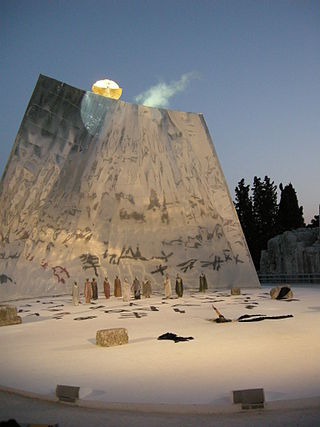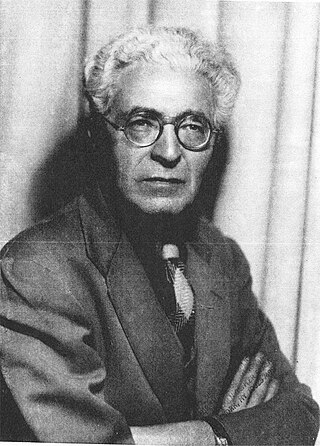
In a literary work, film, or other narrative, the plot is the sequence of events in which each event affects the next one through the principle of cause-and-effect. The causal events of a plot can be thought of as a series of events linked by the connector "and so". Plots can vary from the simple—such as in a traditional ballad—to forming complex interwoven structures, with each part sometimes referred to as a subplot or imbroglio.

In fiction, a character is a person or other being in a narrative. The character may be entirely fictional or based on a real-life person, in which case the distinction of a "fictional" versus "real" character may be made. Derived from the Ancient Greek word χαρακτήρ, the English word dates from the Restoration, although it became widely used after its appearance in Tom Jones by Henry Fielding in 1749. From this, the sense of "a part played by an actor" developed. Character, particularly when enacted by an actor in the theater or cinema, involves "the illusion of being a human person". In literature, characters guide readers through their stories, helping them to understand plots and ponder themes. Since the end of the 18th century, the phrase "in character" has been used to describe an effective impersonation by an actor. Since the 19th century, the art of creating characters, as practiced by actors or writers, has been called characterization.
A plot device or plot mechanism is any technique in a narrative used to move the plot forward. A clichéd plot device may annoy the reader and a contrived or arbitrary device may confuse the reader, causing a loss of the suspension of disbelief. However, a well-crafted plot device, or one that emerges naturally from the setting or characters of the story, may be entirely accepted, or may even be unnoticed by the audience.

Deus ex machina is a plot device whereby a seemingly unsolvable problem in a story is suddenly or abruptly resolved by an unexpected and unlikely occurrence. Its function is generally to resolve an otherwise irresolvable plot situation, to surprise the audience, to bring the tale to a happy ending or act as a comedic device.
Aristotle's Poetics is the earliest surviving work of Greek dramatic theory and the first extant philosophical treatise to focus on literary theory. In this text Aristotle offers an account of ποιητική, which refers to poetry and more literally "the poetic art," deriving from the term for "poet; author; maker," ποιητής. Aristotle divides the art of poetry into verse drama, lyric poetry, and epic. The genres all share the function of mimesis, or imitation of life, but differ in three ways that Aristotle describes:
- Differences in music rhythm, harmony, meter, and melody.
- Difference of goodness in the characters.
- Difference in how the narrative is presented: telling a story or acting it out.
Story structure or narrative structure is the recognizable or comprehensible way in which a narrative's different elements are unified, including in a particularly chosen order and often specifically referring to the ordering of the plot: the narrative series of events. In a play or work of theatre especially, this can be called dramatic structure, which is presented in audiovisual form. The following overviews how story structure works in a cross-cultural and general sense.

Traditionally, conflict is a major element of narrative or dramatic structure that creates challenges in a story by adding uncertainty as to whether the goal will be achieved. In works of narrative, conflict is the challenge main characters need to solve to achieve their goals. However, narrative is not limited to a single conflict. In narrative, the term resolution refers to the closure or conclusion of the conflict, which may or may not occur by the story's end.
A plot twist is a literary technique that introduces a radical change in the direction or expected outcome of the plot in a work of fiction. When it happens near the end of a story, it is known as a twist or surprise ending. It may change the audience's perception of the preceding events, or introduce a new conflict that places it in a different context. A plot twist may be foreshadowed, to prepare the audience to accept it, but it usually comes with some element of surprise. There are various methods used to execute a plot twist, such as withholding information from the audience, or misleading them with ambiguous or false information. Not every plot has a twist, but some have multiple lesser ones, and some are defined by a single major twist.

Screenwriting or scriptwriting is the art and craft of writing scripts for mass media such as feature films, television productions or video games. It is often a freelance profession.
An act is a major division of a theatre work, including a play, film, opera, ballet, or musical theatre, consisting of one or more scenes. The term can either refer to a conscious division placed within a work by a playwright or a unit of analysis for dividing a dramatic work into sequences. The word act can also be used for major sections of other entertainment, such as variety shows, television programs, music hall performances, cabaret, and literature.
Text types in literature form the basic styles of writing. Factual texts merely seek to inform, whereas literary texts seek to entertain or otherwise engage the reader by using creative language and imagery. There are many aspects to literary writing, and many ways to analyse it, but four basic categories are descriptive, narrative, expository, and argumentative.

Lajos N. Egri was a Hungarian-American playwright and teacher of creative writing. He is the author of The Art of Dramatic Writing, which is widely regarded as one of the best works on the subject of playwriting, as well as its companion textbook, The Art of Creative Writing. Beyond the theater, his methods have also been used to write short stories, novels, and screenplays.
A character arc is the transformation or inner journey of a character over the course of a story. If a story has a character arc, the character begins as one sort of person and gradually transforms into a different sort of person in response to changing developments in the story. Since the change is often substantive and leading from one personality trait to a diametrically opposite trait, the geometric term arc is often used to describe the sweeping change. In most stories, lead characters and protagonists are the characters most likely to experience character arcs, although lesser characters often change as well. A driving element of the plots of many stories is that the main character seems initially unable to overcome opposing forces, possibly because they lack skills or knowledge or resources or friends. To overcome such obstacles, the main character must change, possibly by learning new skills, to arrive at a higher sense of self-awareness or capability. Main characters can achieve such self-awareness by interacting with their environment, by enlisting the help of mentors, by changing their viewpoint, or by some other method.
Fiction writing is the composition of non-factual prose texts. Fictional writing often is produced as a story meant to entertain or convey an author's point of view. The result of this may be a short story, novel, novella, screenplay, or drama, which are all types of fictional writing styles. Different types of authors practice fictional writing, including novelists, playwrights, short story writers, radio dramatists and screenwriters.

Writing Drama is a treatise by French writer and filmmaker Yves Lavandier, originally published in 1994, revised in 1997, 2004, 2008, 2011 and 2014. The English version was translated from the French by Bernard Besserglik and published in 2005. The book exists also in Italian, Spanish and Portuguese.
A narrative hook is a literary technique in the opening of a story that "hooks" the reader's attention so that they will keep on reading. The "opening" may consist of several paragraphs for a short story, or several pages for a novel, but ideally it is the opening sentence in the book.
In drama, particularly the tragedies of classical antiquity, the catastrophe is the final resolution in a poem or narrative plot, which unravels the intrigue and brings the piece to a close. In comedies, this may be a marriage between main characters; in tragedies, it may be the death of one or more main characters. It is the final part of a play, following the protasis, epitasis, and catastasis.
Domestic drama expresses and focuses on the realistic everyday lives of middle or lower classes in a certain society, generally referring to the post-Renaissance eras. According to the English Communications Syllabus, domestic drama refers to a dramatic story containing an emphasis on its “characters' intimate relationships and their responses to [the] unfolding events in their lives.” The characters, their lives, and the events that occur within the show are usually classified as 'ordinary' events, lives, and characters, but this does not limit the extent of what domestic drama can represent. Domestic drama does, however, take the approach in which it “concerns people much like ourselves, taken from the lower and middle classes of society, who struggle with everyday problems such as poverty, sickness, crime, and family strife.”a domestic drama is a drama that is usually being used in comedy.

Screenplay: The Foundations of Screenwriting is a non-fiction book and filmmaking guide written by Syd Field. First published in 1979, Screenplay covers the art and craft of screenwriting. Considered a bestseller shortly after its release, to date it has sold millions of copies. It has served as a reference for Judd Apatow, James Cameron, Frank Darabont, Tina Fey and many other professional screenwriters. Now translated into more than a dozen languages, Screenplay is considered the "bible" of the screenwriting craft.








